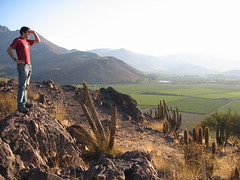Where I live, part one
13 April 2006
1:25 PM

This is the fourth in a series of snapshots of life in Pocuro.
If you ask me where I live, you’re like to hear any one of three answers: Pocuro, Calle Larga, or Los Andes. Sometimes I mix the answers and say something like, “In Calle Larga, near Los Andes.” If you’re a Spanish speaker from outside the area, this answer seems especially unhelpful. Calle larga means “long street”; Los Andes means “the Andes,” and telling you that I live on a long street near the Andes doesn’t exactly pinpoint any specific place. I’m not trying to be vague, though. Let me explain.
Los Andes is a town of about 50,000 that lies 90 minutes north of Santiago. I don’t live there, but it’s the closest major place that Chileans are likely to know. Plus, I do go to Los Andes for work, the internet, mail, and most shopping a few times every week.
Twenty minutes away from Los Andes by bus is Calle Larga, the town where I do live. Roughly 10,000 people live in Calle Larga. The Congregation of Holy Cross runs the parish there, which is how I ended up here. In the town there are 13 sections, each of which is known by a different name and has its own chapel. My section is Pocuro, which has about 1,000 of Calle Larga’s people. Confused yet? Then how’s this for simplicity: my address is “the house next to the chapel in Pocuro.” The wildest thing is that all sorts of people here actually understand that.
The surrounding area in Pocuro is relatively rural. Since we arrived many of the major streets have been paved, but plenty are still just dirt. I hear cars and buses passing on the road, but I’m just as likely to hear a tractor or the clip-clopping of horses’ hooves. People have cell phones mostly because there aren’t land lines in our area. They cook and heat water with gas, which you buy in 15kg tanks from trucks that roam the neighborhood. Houses here, like houses anywhere, vary in their construction. Some are wooden, others are built from adobe, others are little more than shacks. Some have wood floors, other linoleum or time, others dirt.
As for the natural environment, there’s a reason that the nearby town is called Los Andes. Mountains surround me on all sides, like a prairie wagon train surrounds a bonfire. They’re pretty spectacular and somehow comforting because they remind me of the mountains at home in Utah. The ring of mountains creates the valley in which I live. It’s a valley dominated by agricultural activity. There are all sorts of things growing; this region of Chile apparently provides an ideal climate. Above all, it’s grapes—this is wine country.
Seeing it from above quickly reinforced this picture. Last Monday, Tom and I hiked to the top of Pocuro Hill. It’s a molehill compared with the surrounding mountains, but its location offers an informative view of the valley. From the summit, giant rectangles of green stretch out before you to the bases of the mountains. The criss-crossed texture of the grapevines below looks like an unusually groomed field for sporting events. When Tom and I reached the top, the sun was setting before us as the moon rose behind us. In the distance, we could see Aconcagua in Argentina (Chile isn’t a thick country), the tallest mountain in the world outside Asia at 22,841 feet. The scene is impressive in its own right, but doubly so for me—this is where I live.

Comments